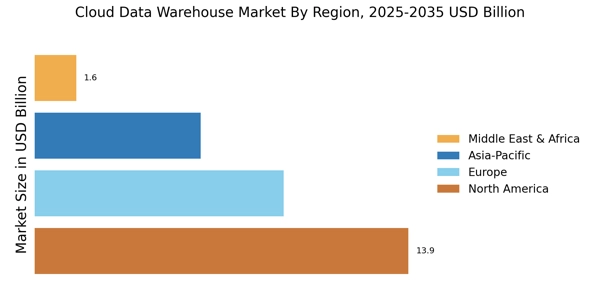The Cloud Data Warehouse Market is currently characterized by intense competition and rapid innovation, driven by the increasing demand for data analytics and real-time processing capabilities. Major players such as Amazon Web Services (US), Microsoft (US), and Snowflake (US) are at the forefront, each adopting distinct strategies to enhance their market positioning. Amazon Web Services (US) continues to leverage its extensive cloud infrastructure to offer scalable solutions, while Microsoft (US) focuses on integrating its cloud services with existing enterprise software, thereby enhancing user experience. Snowflake (US), on the other hand, emphasizes its unique architecture that separates storage and compute, allowing for greater flexibility and cost efficiency. Collectively, these strategies contribute to a dynamic competitive environment, where innovation and customer-centric solutions are paramount.
In terms of business tactics, companies are increasingly localizing their services to cater to regional markets, optimizing supply chains to enhance efficiency, and investing in advanced technologies to improve service delivery. The market structure appears moderately fragmented, with a mix of established giants and emerging players. This fragmentation allows for diverse offerings, yet the collective influence of key players like Oracle (US) and IBM (US) ensures that competition remains robust, pushing all companies towards continuous improvement and adaptation.
In August 2025, Oracle (US) announced the launch of its new Autonomous Database capabilities, which are designed to enhance data management and analytics for enterprises. This strategic move is significant as it positions Oracle to better compete against other major players by offering automated solutions that reduce operational overhead and improve data security. The introduction of these capabilities may attract businesses seeking to streamline their data processes, thereby potentially increasing Oracle's market share.
In September 2025, Snowflake (US) expanded its partnership with Salesforce (US) to integrate their platforms more deeply, allowing for enhanced data sharing and analytics capabilities. This collaboration is strategically important as it not only broadens Snowflake's customer base but also reinforces its position as a leader in the data warehousing space. By aligning with Salesforce, Snowflake is likely to tap into a vast network of businesses that rely on customer relationship management, thus driving further adoption of its services.
In October 2025, Microsoft (US) unveiled its new AI-driven analytics tools within its Azure platform, aimed at providing businesses with deeper insights into their data. This initiative reflects a growing trend towards the integration of artificial intelligence in data warehousing solutions, which is likely to enhance decision-making processes for organizations. By prioritizing AI capabilities, Microsoft positions itself as a forward-thinking leader in the market, appealing to companies looking to leverage advanced analytics for competitive advantage.
As of October 2025, the Cloud Data Warehouse Market is witnessing trends that emphasize digitalization, sustainability, and the integration of artificial intelligence. Strategic alliances among key players are increasingly shaping the competitive landscape, fostering innovation and collaboration. Looking ahead, it appears that competitive differentiation will evolve from traditional price-based strategies to a focus on technological innovation, enhanced service reliability, and sustainable practices. This shift suggests that companies that prioritize these aspects may gain a significant edge in the rapidly evolving market.


















Leave a Comment